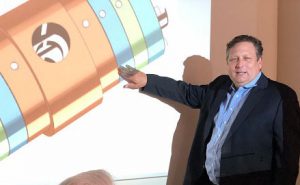Process Fluid Swivel Design Seminar

Kalsi Engineering offers a design seminar for implementing rotary shaft seals in swivels that conduct a product or process fluid. The seminar is intended for mechanical engineers and designers whose responsibilities include the design and maintenance of such swivels. It is offered free of charge and can be presented at your company or ours, or via the internet. To schedule the seminar, or to learn more about our swivel seals, contact us by e-mail, telephone, or through this contact form.
Process fluid swivels with many different configurations, and many different operational challenges, are used in various industries. For example, one general type of swivel conducts fluid through relatively rotating coaxial conduits, another type conducts fluid through radially oriented feed ports in the housing and the shaft, and yet another type conducts fluid through a radially oriented feed port in a stationary housing and then axially through a rotating shaft. Despite the wide range of swivel design variations, similar rotary sealing challenges exist in each.
For example, all the above-referenced swivel designs use rotary shaft seals to separate a pressurized fluid (the process fluid or product) from another fluid (e.g., atmosphere or bearing lubricant). This seminar describes the optional ways such fluid separation can be accomplished with Kalsi-brand rotary shaft seals. This part of the seminar involves a discussion of the features, benefits, and tradeoffs of several different rotary shaft seal designs that have utility in swivel service, and how they are implemented.
The seal implementation portion of the seminar includes a discussion of shaft design that covers various topics including diameter tolerances, surface finish, pressure-related deformation, surface hardening for wear resistance, and things to consider when designing the seal installation path. We also explain the reason why seal-generated heat concentrates in the rotating mandrel, why seal generated heat increases with speed, the implications of excess seal temperature, and techniques (if necessary) for minimizing the temperature of the seals and mandrel.
The implementation discussion also includes a discussion of seal housing design that covers topics such as seal groove geometry and surface finishes, extrusion gap sizing, minimizing seal housing-to-mandrel eccentricity, the implications of inadvertent seal housing-to-mandrel contact, and (if relevant to the customer’s objectives) the optional use of self-aligning seal housings for improved pressure and abrasion resistance, and the optional use of barrier seals.
A lubricant-related section of the seminar describes the preferred classes of lubricants for different seal types, the importance of and techniques for achieving a good initial lubricant fill, and a discussion of seal lubricant supply options. If relevant to the customer’s application, the seminar also includes a discussion of potential bearing related issues. For the benefit of individuals who are unfamiliar with Kalsi Engineering, the seminar also includes an introduction to our company and a description of the key operating principles of our rotary seal product line.
For a list of other rotary shaft seal-related training classes, click here.
